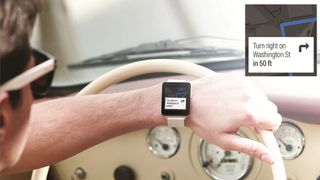Why contextual awareness is about to change the way you use tech
Technology is about to make your life even easier

Fed up with constantly staring at your smartphone to accomplish menial tasks? Apps for this, apps for that, all needing to be downloaded, found, then launched at the appropriate time. Siri and Google Now may think they know what you want, but they have no idea where you are or what you're doing - yet.
Step forward contextual awareness: a new breed of app coming to a smartphone or wearable near you. It promises to make use of the data it collects to second guess, and automate, a lot of your daily tasks.
Soon, apps with some degree of contextual awareness will begin to fire up automatically. "While Google Now and Siri may be useful in spotting how the weather may change or how far you are from home, systems where the smartphone instantly enters relevant modes will ultimately prove far more useful," says Jay Karsandas, Digital Manager at Mobiles.co.uk. "This could include GPS in the car, calorie counters when jogging, or distance trackers when on a bike."
When you sit down on your daily commuter train your most-used app will load - be it music, a game or your email inbox. And when you sit down in front of the TV, your second screen will be ready with Facebook, Twitter or eBay without you having to find the app manually.
What will be contextually aware?
Smartphones and tablets will be contextually aware, for sure, but this will benefit wearables especially. Independent research company Smartwatch Group analysed the 20 most relevant application areas for smart watches in 2020, with personal assistance the clear winner.
"Highly efficient, context-aware management of your calendar, tasks, and information needs" is what we want from a smart watch, apparently, and the example given does sound enticing; your watch tells you when to leave for your next meeting, based on real-time traffic information.

On the back of such contextual awareness, the Smartwatch Group expects half of the estimated 1.6 billion watches that will be sold in 2020 will be connected to the internet.
Get daily insight, inspiration and deals in your inbox
Get the hottest deals available in your inbox plus news, reviews, opinion, analysis and more from the TechRadar team.
Why wearables?
Wearable tech will be one of the most important sources of data for contextual awareness platforms. "The sensors in wearable tech can go beyond what sensors fitted in a smartphone can detect, especially when it comes to health and physical data about the individual using wearable technology," says Henrik Torstensson, CEO of health and fitness platform Lifesum."Data accumulates continuously making services become more and more accurate and complex, based on the patterns and idiosyncrasies of human behaviour."
How will contextually aware apps help us?
Contextually aware apps could become integral parts of our culture. "The perception will be that they significantly improve quality of life, so that more and more people use them, without a second thought," says Torstensson.

He believes the scientifically-based means to assess if we need to go to the gym more, change our sleep patterns, or add an extra green vegetable into our diet will prove irresistible.
What is contextualised search?
Contextualised search goes beyond the barcode scan and the "search by image" feature on Google Images. It's best demonstrated by the Slyce visual search platform.
"Slyce uses proprietary developed image recognition to detect products within user-generated mobile pictures," says Mark Elfenbein, President at the Canada-based Slyce. "Slyce assesses the attributes in these images and matches them against the closest comparable match from a specific retail brand's catalogue."
This white-labelled tech will likely be embedded in future apps from retailers. You'll be able to use a smartphone to snap a photo of a pair of shoes in the store and it will take you to the item's website, send you a discount coupon, or show you a demo video.
However, Elfenbein suggests other uses for Slyce. "Snap a photo of a specific hair-style to receive product information on how to 'get that look', or snap a photo of a home fix-it project to get the necessary tools and supplies to complete job," he suggests.
Jamie is a freelance tech, travel and space journalist based in the UK. He’s been writing regularly for Techradar since it was launched in 2008 and also writes regularly for Forbes, The Telegraph, the South China Morning Post, Sky & Telescope and the Sky At Night magazine as well as other Future titles T3, Digital Camera World, All About Space and Space.com. He also edits two of his own websites, TravGear.com and WhenIsTheNextEclipse.com that reflect his obsession with travel gear and solar eclipse travel. He is the author of A Stargazing Program For Beginners (Springer, 2015),
Most Popular

